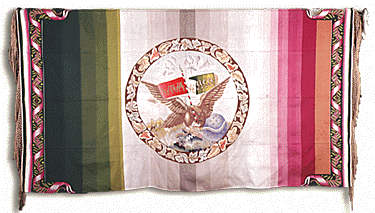
Sarape, c. 1840. Artist unknown, Saltillo, Mexico. Cotton, wool: 80" x 59". Gift from Patsy and Marshall Steves.
The pedal loom and sheep wool introduced by the Spanish revolutionized Mexican weaving. In the 18th century, beautiful sarapes with geometric patterns were sold in Saltillo to wealthy buyers at trade fairs. Collectors today prize the skilled artisanship and high warp and weft count that characterize 18th- and 19th- century Saltillo sarapes.
This sarape was woven during the Republican period and features the Mexican eagle on a cactus, the emblem on the Mexican flag which refers to the Aztec migration myth.